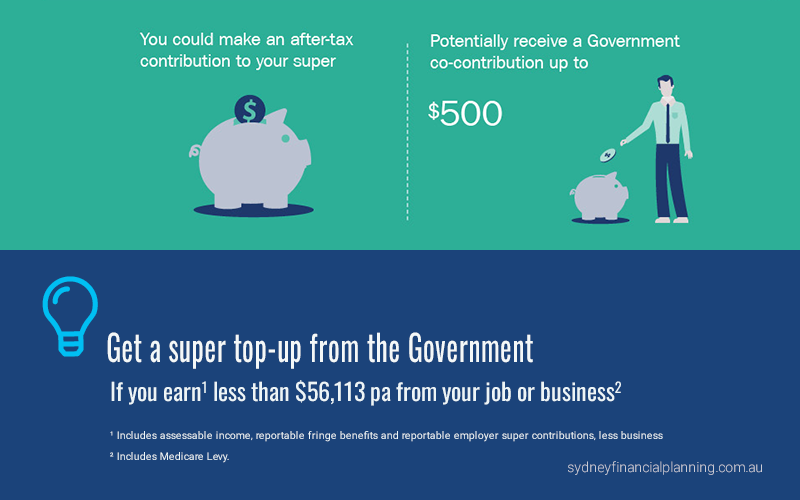If your income is under a certain threshold, then making personal after-tax super contributions could enable you to qualify for a Government co‑contribution and take advantage of the low tax rate payable in super on investment earnings..
How does the strategy work?
If you earn¹ less than $56,112 pa (of which at least 10% is from eligible employment or carrying on a business) and you make personal after-tax super contributions, the Government may also contribute into your super account. This additional super contribution, which is known as a co-contribution, could make a significant difference to the value of your retirement savings over time. To qualify for a co-contribution, you will need to meet a range of conditions, but as a general rule:
- the maximum co-contribution of $500 is available if you contribute $1,000 and earn $41,112 or less
- a reduced amount may be received if you contribute less than $1,000 and/or earn between $41,113 and $56,112, and
- you will not be eligible for a co-contribution if you earn $56,113 or more.
The Australian Taxation Office (ATO) will determine whether you qualify based on the data received from your super fund and the information contained in your tax return for that financial year.
As a result, there can be a time lag between when you make your personal after-tax super contribution and when the Government pays the co‑contribution.
If you’re eligible for the co-contribution, you can nominate which fund you would like to receive the payment.
Alternatively, if you don’t make a nomination and you have more than one account, the ATO will pay the money into one of your funds based on set criteria.
Note: Some funds or superannuation interests may not be able to receive co-contributions. This includes unfunded public sector schemes, defined benefit interests, traditional policies (such as endowment or whole of life) and insurance only superannuation interests.
Other key considerations
- You can’t access super until you meet certain conditions.
- You may want to consider other ways to contribute to super, such as salary sacrifice or personal deductible contributions.
Seek advice
A financial adviser can help you determine whether you should make personal super contributions and assess whether you will qualify for a Government co-contribution.
Case Study
Ryan, aged 40, is employed and earns $35,000 pa. He wants to build his retirement savings and can afford to invest $1,000 a year.
After speaking to a financial adviser, he decides to use the $1,000 to make a personal after-tax super contribution.
By using this strategy, he’ll qualify for a cocontribution of $500 and the investment earnings will be taxed at a maximum rate of 15%.
Conversely, if he invests the money outside super each year (in a managed fund, for example), he will not qualify for a cocontribution and the earnings will be taxable at his marginal rate of 21%
Details
|
Receive pay rise as after-tax salary
|
Sacrifice pay rise into super
|
|---|
| Amount invested |
$1,000 |
$1,000 |
| Plus co-contribution |
Nil |
$500 |
| Total investment |
$1,000 |
$1,500 |
| Tax rate payable on investment earnings |
21%2 |
15% |
Next steps
Contribution rules and eligibility criteria for catch up CCs are complex. This guide is not designed to provide comprehensive information about how the rules work or apply to you. It is important that you speak with your financial adviser, your registered tax agent and visit the ato.gov.au for more information.
If you aren't sure how to proceed or if you meet the specific criteria...
Speak with one of our Financial Planners about the best approach for your circumstances asap, either book a meeting or get in contact with us on 02 9328 0876.
1Includes assessable income, reportable fringe benefits and reportable employer super contributions, less business deductions and assessable First Home Super Saver amounts. Other conditions apply.
2 Includes Medicare Levy.
General Disclaimer: While every care has been taken in the preparation of this document, Sydney Financial Planning and Charter FP make no representations or warranties as to the accuracy or completeness of any statement in it.This article contains information that is general in nature. It does not take into account the objectives, financial situation or needs of any particular person. You need to consider your financial situation and needs before making any decisions based on this information. Please seek personal financial advice prior to acting on this information.

